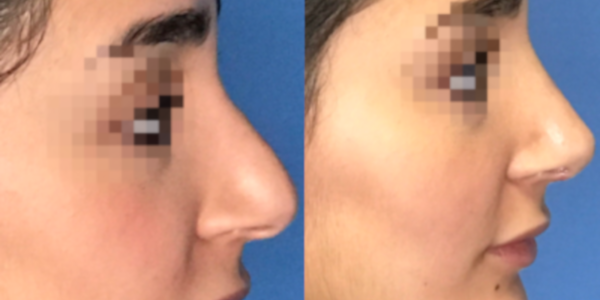Nostril Reduction Surgery – Frequently Asked Questions
Nostril Reduction Surgery FAQs
Noses are like snowflakes – no two are identical. And what one person finds appealing may not fit another person’s ideal of how they wish to look. For some people, even a perfectly likeable nose can be diminished (in their opinion), by wide nostrils.
Even if the nose is the right size for the rest of the face, enlarged nostrils can make the nose seem larger or slightly out of proportion. And being dissatisfied with your nose can negatively impact a person’s self-esteem. The bottom line is that it’s your nose … and rhinoplasty or nostril reduction surgery can help you adjust its appearance to make you happy! What is nostril reduction?
Technically, nostril reduction surgery is called “alarplasty”. It is a specific type of rhinoplasty or “nose job”.
Also known as “alar base reduction surgery”, Nostril Reduction is a surgical operation that alters the base of the nose. It can help people who wish to narrow the appearance of nasal flaring, as well as patients seeking more symmetry in their nose’s form.
Nostril reduction surgery can also make the size of the nostrils more proportionate to the rest of the nose and face – which can enhance the aesthetic appearance of the entire face.
How do I Know What Nostril Reduction Will Look Like?
The decision to alter the shape of one’s nose is a personal one and should be handled with care and careful consideration. Dr. Ali will perform a facial examination during your consultation to discuss your appearance goals, and to help you determine the ideal proportions for your unique nose and nostrils.
To make your decision easier, our advanced Vectra-3 diagnostic computer imaging system can allow patients to see their nostrils from the side, behind, front, and above before electing to surgery. Then it will show you a series of images of what the nose might look like after different surgery options. This way you can visualize your nostril reduction results before you undergo the procedure!
How Will Nostril Reduction Surgery be Performed?
Dr. Ali is skilled in changing the scale and breadth of the nostrils while minimizing or preventing the appearance of any scars. This is achieved by making a series of thin, barely visible incisions within the nose’s base.
The “Weir excision” is one of the most common techniques used by Dr. Ali to shorten the nostril foundation and reduce the nostril sidewalls, to enhance the overall appearance of the nose. Other types of incisions may, however, be used if Dr. Ali should decide that they would produce the best possible results. The intention, of course, is to keep the nose’s base looking as natural as possible, while still reducing the width.
The “wedge procedure” is another nostril reduction technique. By eliminating wedges of alar (the fleshy, angled lower portion of the nose that connects to the cheek) wedge excisions eliminate nasal flaring. In this process, the incisions are made along the outside of the nostril but do not narrow it. Instead the incision “detaches” the nostril subtly from the cheek – for a less “flared” appearance. There is also the Sill technique – which is used to limit nostril width and shorten the base of the alar, at the point where it attaches to the cheek.
Based on what you and Dr. Ali decide during your Vectra 3D imaging session, Dr. Ali will select the best surgical technique for your appearance goals.
How Does Nostril Reduction Surgery Effect People of Color?
People of different ethnic origins naturally have certain types of hair, eye colors, and skin tones specific to their ethnicity. And the nasal structure of different ethnicities is also often equally unique to their heritage. For example, men and women of African origin usually have a nose that is more flat and broad, often with a wider base, or a more rounded tip. And, in addition to differences in genetics, different cultures also have their own unique concepts of beauty.
Dr. Ali is a talented rhinoplasty surgeon who is skilled at enhancing a person’s natural beauty while still preserving their ethnic heritage and identity.
When it comes to rhinoplasty or nostril reduction, it’s important for people of color to find a board certified plastic surgeon like Dr. Ali who doesn’t simply create “one-size-fits-all” noses. Dr. Ali is a rhinoplasty expert and Board-Certified Plastic Surgeon who tailors each rhinoplasty surgery to the patient’s facial features and proportions, while respecting their genetic heritage, and and honoring their cultural beauty ideals.
How Long is the Recovery Process Following Nostril Reduction Surgery?
When compared to other types of facial plastic surgery, the recovery period for nostril reduction surgery is comparatively short. Initially, the nose will be red and swollen, but this will gradually subside over the following 1 to 2 weeks. The stitches are usually removed approximately one week after surgery.
While nostril reduction surgery puts very few restrictions on the patient during recovery, first and foremost the patient must take care not to injure the nose while it is healing. So, strenuous or rough activities, such as exercising and most types of athletics should be avoided until the nose is fully healed in place.
Nostril Reduction Surgery – Birmingham, MI
Dr. Ali is one of the leading rhinoplasty surgeons in Birmingham, MI and the entire Detroit area. He is highly skilled in minimally invasive and scarless nostril reduction surgical procedures. Dr. Ali has spent years honing his expertise in this sensitive and complex area of plastic surgery, and he is passionate about designing noses that are both cosmetically and clinically superior.
Schedule a nostril reduction consultation today, and see exactly what Dr. Ali can do to help you achieve your appearance goals!




